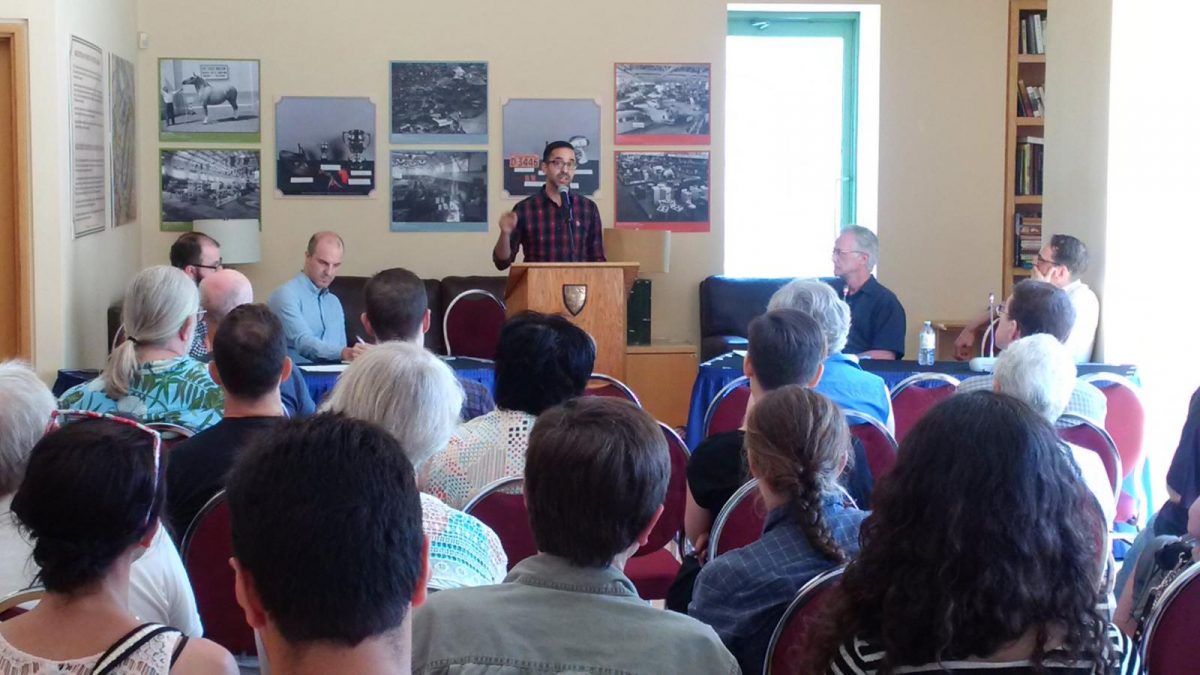Against: Tasman Richardson and Marc Fursteneau
For: Ryan Stec and Christopher Payne
Hosted by Dr. Geoffrey Gurd
This debate occurred in the context of Tasman Richardson’s show Necropolis presented in collaboration with the city of Ottawa at the Karsh-Masson Gallery. More about the exhibit and a critical reflection, The Now of Tasman Richardson, by Artengine’s Artistic Director.
As the collection of technologies producing moving images multiplies at an incredible rate, Artengine wondered about the supposed ascent of video. Has one of the defining mediums of the twentieth century truly come to dominate the twenty-first or did something else happen? While the word video is unavoidable and ubiquitous has it also become hollow and meaningless? It is everywhere and so perhaps nowhere? Is it, at best, like a state of matter, a general category that barely defines its material existence, gas, solid or liquid? Beyond the most general quality of the moving image does it have definition, does it have connective tissue, does it have anything we can speak of in a meaningful way?
Of course, these assertions are counter intuitive and perhaps both ridiculous and preposterous, but if dialogue only organizes itself around what is reasonable and believable how will we arrive at anywhere new and interesting? And so we set ourselves an almost impossible task, to assert that despite what you think you see all around you, that despite this video is in fact dead. It has ceased to be and something else has replaced it. Something else we must find a name for.
This is not a fair and balanced introduction, but the ‘against’ side of this debate clearly has the advantage, and so we have taken some liberties. For our spirited discussion on the death of the medium, which we have recorded and edited to be presented below, we invited cinema scholar Marc Fursteneau to join artist Tasman Richardson in the defense of video, its multiplicity and its vitality. Asserting the preposterous is Artengine’s Artistic Director Ryan Stec and media artist Christopher Payne.
We hope you enjoy the conversation.
Biographies
Against
Tasman Richardson is a video artist, electronic composer, and graphic designer. For over a decade he has exhibited or performed extensively throughout the Americas, Europe, North Africa and Asia. He lives in Toronto, Canada. His work focuses on tele-presence, memory, appropriation, synesthesia, and JAWA editing (of which he is the founder). His artworks are available through Vtape, V-Atak, tasmanrichardson.com, Art Metropole, The National Gallery of Canada, and Neubacher Shor Contemporary.
Marc Fursteneau is an Associate Professor in Film Studies at Carleton University. He received his PhD in Communications from McGill University, and has a BA and an MA in Comparative Literature and Film Studies from the University of Alberta. His interest in research include film theory and history, new digital media, documentary cinema and cultural and media studies. He has published on cinema and semiotics, film theory, on the philosophical cinema of Terrence Malick, and on the photographic theory of Susan Sontag. He has also edited an anthology of classic texts in film theory, The Film Theory Reader: Debates and Arguments (Routledge 2010), and is the co-editor of a volume of essays entitled: Cinema and Technology (Palgrave 2008). He is presently preparing a book on the relations between film theory and technological change.
For
Christopher Payne holds a BFA from Mel Hoppenheim School of Cinema at Concordia University, and an MFA from the University of Ottawa. He has exhibited and performed work in Gatineau, Ottawa, Edmonton, Montreal, Vancouver, Belgium, and Poland. His work includes installation, performance, photography, and expanded cinema. Payne is recently left his position as Production Director at EMMEDIA Gallery and Production Society to return to the cultural landscape of Ottawa, and is part time professor in the Visual Arts Department at the University of Ottawa.
Ryan Stec is an artist, producer and designer working in both research and production. Beginning his relationship to the moving image through documentary, his practice has slowly expanded off the edges of the screen increasingly combining light, color, structure and material with deeper consideration of site and the city. As a producer he has developed creative methods to facilitate collaboration across disciplinary boundaries, and as a researcher is focused on how making could be understood as a research methodology. He has been heavily involved in the artist-run culture of Ottawa since 1998; is the Artistic Director of Artengine, a center for art, design and research here in the capital, and is currently pursuing a PhD in Architecture at Carleton University.

